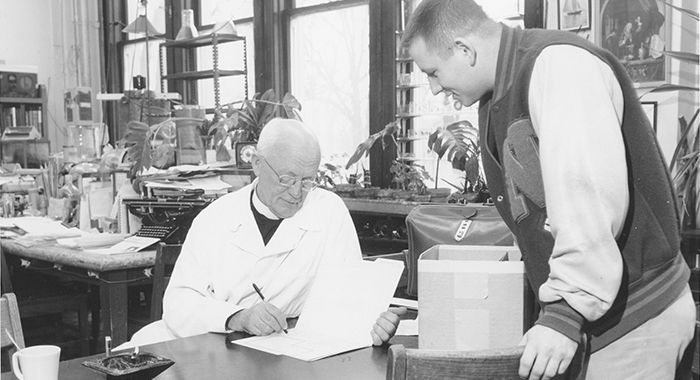One for the Ages: Boyle Hall Celebrates Its Centenary
It is the indentations in the Boyle Hall steps that move Dave Klopotek ’64 (Chemistry, Emeritus). “I always felt I had to step in those, to follow in the footsteps of all those who went before me.” Every St. Norbert alum still living once took classes within its walls, and many studious generations to come will enter between its pillars. This semester marks 100 years since Boyle Hall first opened its doors to undergraduates hungry for learning. And, for a good part of the building’s history, there were high school students, too.
Those three steep flights of broad steps were not the only route to the top, although they were probably the surest. Ken Zahorski (English, Emeritus) recalls that, in the early years, the elevator was notoriously unpredictable, and was always getting stuck in between the floors. “Ed Hruska in Communications would take it nearly all the time. I can see his head, and I could see he was chewing gum – because that was all you could see. He was chewing his gum and waiting. I don’t know how many times he had to be rescued from that elevator.”
The interplay between a building and its occupants takes shape over the years. The building had its eccentricities, remembers Bob Boyer (English, Emeritus). When the space was divided up to create more faculty offices, the majority of those were inner rooms, partitioned with spaces at the top and bottom of the walls: “I had to get something from Jim Benton’s office one Saturday – and I could get into the complex, but your doors could lock which, of course, was kind of ridiculous. I ended up climbing over the top of the partition and getting the paper I needed, and then making my escape.” It’s a story that puts Eliot Elfner (Business Administration, Emeritus) in mind of what he terms the beauty of Boyle Hall, back in the day: “We had multiple disciplines next to one another. You just got an office where you were. We didn’t group by disciplines as we do now.” Ahead of the 1984-85 renovation, Mural Adams (Education, Emeritus) was in charge of moving those professors out of Boyle into “other nooks and crannies. The dean said he gave me $2,000 [for this role] primarily to keep all those people out of his hair. I didn’t get into a quarrel with anybody!”
That renovation would bring with it a welcome new amenity: air conditioning. “You can’t imagine how hot the two upper floors got in mid-summer,” says Zahorski. “You were just always hoping that someone with a window office would open a window. A great deal of smoking went on, both on the part of faculty and students. Every desk, you would have an empty tuna or salmon can for an ashtray. Sometimes you would look at your class through a smoky haze.”
On occasion, the local paper mill would contribute its own notes to the special Boyle Hall atmosphere. “When I asked about the smell I was told that was the smell of employment,” recalls Karina O’Malley (Sociology, Emeritus).
Henry Boyle himself would have agreed. No stranger to industry himself, he was, in fact, a prominent yeast manufacturer who, with his wife, Julia, funded the building’s construction in gratitude for the fine education received by their son, Francis H. Boyle, Class of 1916, (after whom the edifice is named).
Nov 10, 2017












